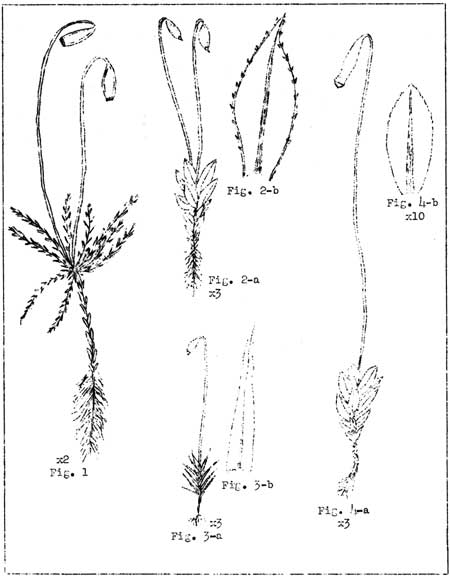
-oOo-

BRYUM FAMILY (BRYACEAE)
As previously mentioned in this work, the Bryaceae are widely
distributed on Mt. Rainier. Practically all mosses found so far belong
to two genera namely Bryum and Pohlia, one species of Leptobryum, i.e.,
L. pyriforme (L) Schimp., having been found. This latter genus, formerly
considered a subgenus of Bryum, is distinguished from Pohlia by the
perfect peristome and very narrow leaves with broad leaves with broad
costa. Apparently the best separation of Pohlia and Bryum is on the
basis of the leaf cells, Pohlia having elongated leaf cells 4:1, while
Bryum has shorter leaf cells, less than 4:1.
KEY TO SPECIES OF POHLIA
| 1-Capsules when mature about as
wide as long | ...P. Wahlenbergii. |
| 1-Capsules when mature as long
as wide | ...2. |
| 2-Leaves numerous
and large with metallic lustre | ...P.
Cruda. |
| 2-Leaves without
pronounced lustre | ...2. |
| 3-Male and female organs in
same inflorescence | ...P. Nutans. |
| 2-Male and female organs in
separate inflorescence | ...3. |
| 3-Having few, if
any, gemmae in leaf axils | ...P. Drummondii. |
| 3-Having
conspicuous gemmae in leaf axils; leaves narrow, green, gemmae
elongated | ...P. annotina. |
Pohlia wahlenbergii (Web. & Mohr.) Andrews, is the highest
collection in the park, having been collected by G. K. Patterson at the
summit in August, 1936 and 1937. It was not in fruit at the time but
formed loose, low-growing tufts of a light-green color on the reddish
pumice and ash of the crater rim.
P. Cruda (L) Lindb. was likewise not found in fruit, although
collected twice on Fremont Peak and once near Longmire. As indicated in
the key, it is distinguished by a metallic lustre of the leaves, which
are on erect stems.
P. nutans (Schreb) was by far the most frequently encountered
of the Bryaceae (See Plate XIV, Fig. 3). It is quite small, usually 2 to
4 cm. in height and marked by a distinct reddish appearance of the stem
and leaves. It was collected in Devil's Dream Canyon, above Lake Louise,
on Eagle Peak Trail, at Ohanapecosh, and other places. It is
particularly abundant on the trail up to the Nisqually Glacier.
P. Drummondii (C.M.) Andrews is a small plant with stems
usually not over 1 cm. in height with seta also short; color of plant
yellow-green to brown; collected above Lake Louise where it is quite
abundant in wet meadows.
P. annotina (Hedw.) Loeske, is also quite small and slender,
and often takes on a pronounced reddish color. Sterile stems bear ovoid
gemmae in the axils of the upper leaves. It is found on the Van Trump
Trail at 4800 feet elevation, and is fairly common in dry, open places
about Longmire.
Leptobryum pyriforme (L.) Schimp. known as the Long-necked
Bryum, is a beautiful form recognized by the long-necked capsules and
slender leaves. It frequents moist places along the Nisqually River
Trail.
MNIUM FAMILY (MNIACEAE)
Among the largest and most beautiful of all our mosses, the Mniums
grow in moist, shaded places on ground that is rich in humus;
consequently on Mt. Rainier they occupy the lower life zones in the deep
shade of the forest. A single genus, Mnium.
KEY TO THE SPECIES
| 1-Plants looking like small
trees with numerous small white scales on stem | ...Mnium
acanthoneura |
| 1-Plants not as
above | ...2. |
| 2-Leaves entire
| ...M. punctatum. |
| 2-Leaves serrate
| ...3. |
| 3-Teeth of leaves single
| ...4. |
| 3-Teeth of loaves in pairs
| ...5. |
| 4-Basal branches
forming stolons; leaves acuminate | ...M.
medium. |
| 4-Basal branches
erect; stems simple; leaves serrate | ...M.
insigne. |
| 5-Capsules solitary |
...M.
pseudolycopodiodes. |
| 5-Capsules
clustered | ...M. spinulosum. |
Mnium acanthoneura (L) (See Plate XIV, Fig. 1) is described in
Lesquereux and James' Manual under Leucolepis, a name applied because of
the whitish scales covering the stem. The plant is tree-like, with a
cluster of branches at the tip, together with several Mnium-like
capsules. It is to be found in moist, shaded stream courses below
Longmire end above on Huckleberry Creek.
M. punctatum L., The Early Mnium, grows on moist stones and
along streams and canyons such as Van Trump Canyon. It is easily
recognized by its entire leaves, which are apiculate with the costa
percurrent.
M. medium (B. & S.) is a fairly robust form distinguished
by stolons formed by the basal branches. At the edge of the leaf can be
seen the paired teeth. Collected near Ohanapecosh Hot Springs.
M. insigne Mitt, differs from the above species by its simple
stems. It was collected in the moist forest along the Nisqually
Road.
M. pseudolycopodiodes (C.M.) Kindb. has the costa of the upper
leaves excurrent and the capsules solitary. The single collection of
this species made in the park so far was on the Klapatche Trail.
M. Spinulosum (Br. & Sch.) (See Plate XIV, Fig. 2), the
Red-mouthed Mnium, is distinguished, as the name indicates, by the
bright-red peristome. Specimens were collected at Ohanapecosh and also
on the north side of the park along the road leading up to the Carbon
Glacier.

PLATE XIV.
Fig. 1. (Mniaceae). Mnium acanthoneura. Entire plant x2.
Fig. 2. (Mniaceae). Mnium spinulosum B. & S. 2a - entire plant
x3. 2b - leaf, magnified to show double teeth at margin.
Fig. 3. (Bryaceae). Pohlia nutans Schreb. 3a - entire plant x3.
3b - leaf, magnified highly.
Fig. 4. (Bryaceae). Bryum lucidum E.G.B. 4a - entire plant x3.
4b - single leaf, magnified about x10.
Descriptions continued...

